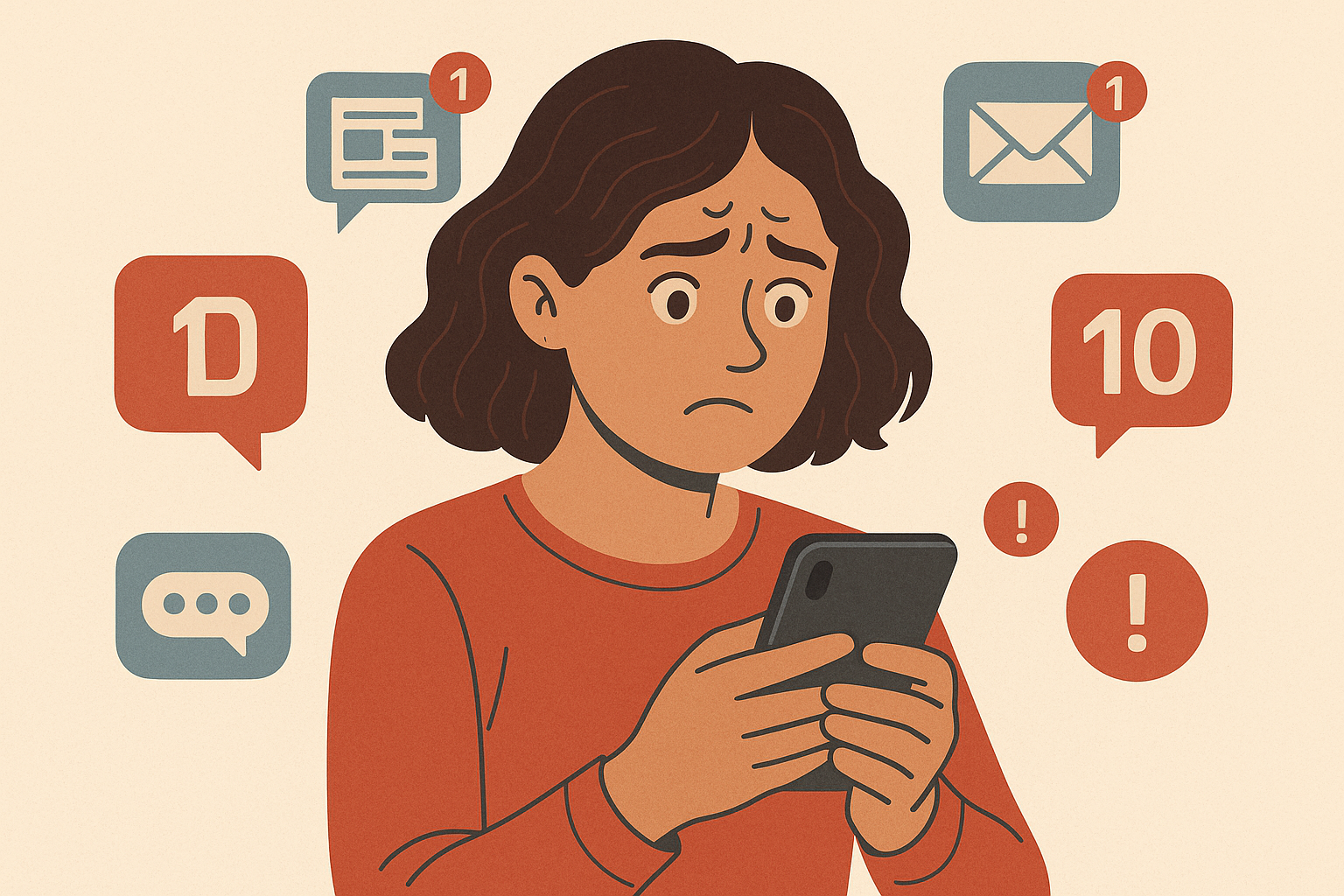Is Your Phone Making You Anxious? Use It to Heal Instead

We spend hours a day on our phones scrolling, messaging, checking, comparing. It’s become second nature. But what if the very device we rely on is quietly fueling our anxiety?
Research shows that excessive phone use, especially for social media and news, is linked to rising levels of stress, anxiety, and poor sleep. Notifications, endless feeds, and pressure to stay constantly connected can leave us feeling overwhelmed and mentally drained.
But it doesn’t have to be this way.
Your phone doesn’t have to be the enemy of your mental health. In fact, with the right tools, it can become one of your biggest allies in healing. At Aitherapy, we believe that technology, when used intentionally, can be a powerful force for emotional support and self-awareness.
Let’s explore how your phone might be making your anxiety worse and how you can turn it into a source of calm, clarity, and real mental health care.
The Hidden Ways Your Phone Triggers Anxiety
Most of us don’t realize how often our phones spike our stress levels. It's not just screen time that matters it’s what’s on the screen, how often we check it, and the constant mental load that builds up.
Here are the subtle but powerful ways your phone could be increasing your anxiety:

1. Notification Overload
Every ping, buzz, and badge grabs your attention and triggers a stress response. Even when you ignore them, your brain doesn’t. Over time, this puts your nervous system in a constant state of alertness.
2. The Comparison Trap
Social media feeds are highlight reels. You scroll through carefully curated moments and subconsciously compare them to your unfiltered life. This can fuel self-doubt, low self-esteem, and a nagging feeling of “I’m not doing enough.”
3. Doomscrolling
Stuck in a loop of bad news? That’s doomscrolling. Whether it’s global conflict, health scares, or financial crises, constant exposure to negative content can leave you feeling helpless and emotionally exhausted.
4. Poor Sleep Hygiene
Using your phone before bed exposes your eyes to blue light, which interferes with melatonin production. Plus, emotionally stimulating content (like emails or intense videos) can keep your brain wired long after you’ve put your phone down.
5. Phantom Vibrations & Obsessive Checking
Ever feel your phone vibrate when it didn’t? Or catch yourself unlocking it every few minutes without a reason? These habits are symptoms of digital overstimulation and anxiety-driven behavior patterns.
Reclaim Your Screen, Turn Your Phone into a Mental Health Tool
It’s easy to blame your phone for your anxiety but the truth is, your phone is just a tool. The way you use it is what makes the difference.
Instead of cutting out screen time completely (which often isn’t realistic), you can rewire your relationship with your phone so that it supports your mental health instead of harming it.
Here’s how to start:
1. Declutter Your Digital Space
Remove anxiety-triggering apps from your home screen—or uninstall them entirely. Move email and social media into folders, and place calming tools front and center.
2. Create a Mental Health Toolkit
Download apps that support your emotional wellbeing. Think: meditation, journaling, breathing exercises and of course, Aitherapy. Add them to your dock so they’re easy to access when you feel overwhelmed.
3. Use Focus Modes or App Limits
Both iOS and Android allow you to schedule focus times where distracting apps are silenced or hidden. Setting daily screen limits for social media can also reduce compulsive checking.
4. Replace Mindless Scrolling with Meaningful Support
Next time you feel the urge to scroll, open Aitherapy instead. Within seconds, you can message a trained, CBT-based AI therapist and receive calm, supportive guidance anytime, anywhere.
5. Make Your Phone a Space for Recovery
Add widgets with affirmations. Schedule daily check-ins. Use calming background colors. Make your phone feel like a safe, healing place rather than a source of chaos.
How to Start Small: Create Your Healing Home Screen
You don’t need a full digital detox to feel better. In fact, small changes in how you organize and use your phone can make a big difference. The goal is not to fight your phone, but to make it a calmer, safer space.
Here’s how to create a healing home screen in five simple steps:
Step 1: Move anxiety triggers out of sight
Relocate apps that often spike your stress like email or social media off your main screen. You can still access them when needed, but they won’t be the first thing you see when you unlock your phone.
Step 2: Add mental health tools to your dock
Keep supportive tools like Aitherapy, a meditation app, or a journaling app within immediate reach. This makes it easier to reach for something helpful when you’re feeling overwhelmed or lost.
Step 3: Set a 2-minute daily check-in
Use a reminder or calendar event to pause once a day and open Aitherapy. Share what’s on your mind, even if it’s just a sentence or two. This tiny habit builds emotional awareness over time.
Step 4: Use widgets for calm and clarity
Many phones let you add widgets to your home screen. Try one that displays calming quotes, mood trackers, or breathing prompts to shift your focus and keep you grounded throughout the day.
Step 5: Protect your evenings
Set your phone to “do not disturb” at least one hour before bed. Keep stimulating apps out of reach during this time, and instead, open Aitherapy or a mindfulness app to wind down.
When you build your home screen intentionally, you transform your phone from a source of stress into a personal space for healing. It becomes a tool for support, not escape.
Your Phone Isn’t the Problem. Your Relationship With It Is.
It’s tempting to blame technology for how we feel but phones aren’t good or bad on their own. Like any tool, their impact depends on how we use them.
When we scroll mindlessly, chase notifications, and let our phones control our attention, it’s no surprise we feel anxious. But when we slow down, set boundaries, and use apps that support our emotional health, the same device becomes something entirely different. It becomes a source of connection, reflection, and healing.
Here’s the shift in mindset that makes all the difference:
- Instead of using your phone to escape, use it to engage with how you feel.
- Instead of drowning in information, choose tools that help you organize your thoughts.
- Instead of waiting for the perfect moment to ask for help, reach out now quietly, privately, and on your own terms.
Aitherapy was built for this purpose. It’s not just another app. It’s a space where you can express what’s bothering you, explore your emotions, and get responses grounded in real psychological techniques. No waiting rooms. No pressure. Just support that fits into your life.
Your relationship with your phone can either drain you or refill you. When you take control of that relationship, you open the door to a calmer, more intentional way of living.
A New Way to Look at the Screen in Your Hand
You don’t have to throw your phone away to protect your mental health. You just have to use it differently.
What once caused stress can now bring relief. What once led to spirals can now help you find your center. All it takes is the right approach and the right tools.
With Aitherapy, your phone becomes more than a distraction. It becomes a safe space. A source of support. A tool you can turn to in moments of doubt, panic, or quiet sadness. Whether you’re lying awake at night, taking a break at work, or just feeling off for no clear reason—you can open the app, type a message, and start feeling better within moments.
Technology doesn’t have to be toxic. It can be a lifeline.
So the next time you reach for your phone, ask yourself:
Is this helping me or hurting me?
And if you’re ready for help that’s always there, always judgment-free, and always focused on your wellbeing Aitherapy is right here in your pocket.
Try it today. Let your phone support your healing.





